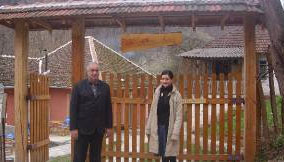
Daughter Sanja Knezevic and father Dragan Knezevic at the entrance to the ethno village Latkovac
The first ethno village in Rasina district “born” thanks to the Knezevic family who reconstructed the hearth of their forefathers.
Half of Serbia’s population lives in villages and one third of them work on land to make a living. Regretfully, the reality is not rosy – Serbian villages are dying out. According to the projections one in four villages will disappear from geographic and demography maps over the next fifteen years. This trend is no different from than in Europe where outflow from villages was one of the characteristics of the 20th century. Socio-economic changes and demographic depletion of villages in Serbia began back in the 60s. The general crisis of the late 80s lead to additional movements into urban areas.
The Knezevic family summoned up courage and set about reviving the village of Latkovac, municipality of Aleksandrovac in 2006. On a farm where the ancestors of Dragan, head of family, lived, they constructed an ethno village. Dragan and his wife Ruzica who have worked in catering for over 40 years and their three daughters received RSD 3 million loan from the then Ministry of Trade, Tourism and Services and, topping them with their own funds, began reconstruction of the village of Latkovac. The total value of the project was assessed at RSD 13.5 million. RSD 5 million are lacking to complete it. Regretfully, cooperation was not established with the municipality, аnd with the exception of the loan in 2006, there had been no other help from state institutions.
“ Reconstruction of houses over 100 years old began in September 2006. The problem was that the workers did not know how the techniques of building with mud and roll. Nevertheless, we managed to complete the houses in less than six months. We had our first guests last summer – recalls Sanja Knezevic, a student of archeology who decided to go into the family business after graduation. She already returned to Latkovac. With a smile on her face she says that village tourism is a way to keep the young people in rural parts of Serbia.
Three vividly coloured houses: blue, red and green, have 26 beds.
A spacious dining room is located in the former winery, converted into a prison and courthouse. The first ethno village in the Rasina district is located 56 km away from Kopaonik, 30 km from Kusevac and 56 km from Kraljevo. Unspoilt nature, paths, the nearby four archeological sites of the old town of Koznik are a recommendation in themselves.
In the first year of operation they has some 3,000 daily visits and up to 500 overnight stays. At the time of wine picking in Latkovac a traditional wedding was organised. The village was a host to students from Western Europe.
Cooperation was established with the Society MNRO from Aleksandrovac. Tapestries, pottery and other handmade products of the members of the Society are sold in the ethno shop. In June the village will host 40 persons with disabilities who will be trained in pottery making and old crafts – a useful therapy for them.
The village used to be one of the largest in the region, but has only 400 inhabitants today. It is the wish of the Knezevic family to restore the old splendor and add something new to the old wine producing and cattle herding centre. The artistic, educational and cultural character of the ethno village Latkovac also employs a caretaker and several seasonal workers in summer. The local population offers the guests local products and one cannot neglect the social development of the village.
 Government of the Republic of Serbia
Government of the Republic of Serbia














 pdf [271 KB]
pdf [271 KB]
Leave a Comment